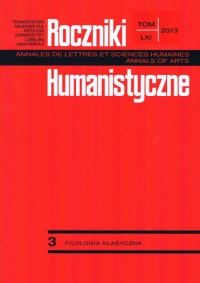Poetry ars divina: Musaeus’ Prophetic Oration in the Epic Poem Radivilias by Jan Radwan
Abstract
Heroic epic poem entitled Radivilias sive de vita et moribus praeclarissime gestis immortalis memoriae illustrissimi principis Nicolai Radivili … libri quattuor, by Jan Radwan, was published in Vilnius in 1592.
The historical narration about the chief events connected with the Livonian War (1558-1582) when Poland and the Great Duchy of Lithuania were struggling against Ivan, the Terrible serves as a setting for a panegyric portrait of the main hero of the poem, Mikołaj Radziwiłł, the Red and his heroic deeds.
The author of Radivilias takes Radziwiłł to Helicon, place sacred to a succession of poetic memories, where he meets Musaeus. This part of the poem resembles Cicero’s Dream of Scipio, but we can see an essential difference between these two texts (Cicero - dream, dead ancestors, rational justification, Radwan - mythological motif, legendary poet Musaeus and poetry as a source of wisdom). Radwan is very realistic. He does not dream about return of the Golden Age, but emphasises the fragility of earthly glory and concentrates his attention upon the only true life - the life after death.
This article aims at discussing Radwan’s conception of the function of the Musaeus’ prophecy in the whole context of the poem. The attention is being given also to a prohetic significance of poetry.
References
Brahmer M.: Renesansowy mit poety-wieszcza, w: Księga pamiątkowa ku czci Stanisława Pigonia, Kraków: PAN 1961.
Besala J.: Zygmunt Stary i Bona Sforza, Poznań: Zysk i S-ka 2012.
Michałowska T.: Poetyka i poezja, Warszawa: PWN 1982.
Norwid K.C.: Pisma wszystkie, t. II, Warszawa: PIW 1971.
Sarnowska-Temeriusz E.: Poetyka okresu renesansu. Antologia, Wrocław: Zakład Narodowy im. Ossolińskich 1982.
Szczerbicka-Slęk L.: W kręgu Klio i Kaliope. Staropolska epika historyczna, Wrocław: Zakład Narodowy im. Ossolińskich 1973.
Copyright (c) 2013 Roczniki Humanistyczne

This work is licensed under a Creative Commons Attribution-NonCommercial-NoDerivatives 4.0 International License.





